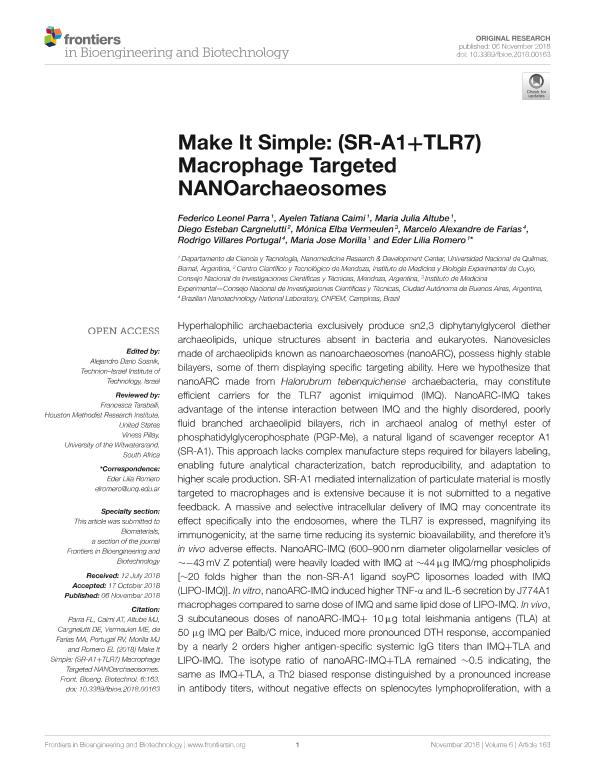Mostrar el registro sencillo del ítem
dc.contributor.author
Parra, Federico Leonel

dc.contributor.author
Caimi, Ayelen Tatiana

dc.contributor.author
Altube, María Julia

dc.contributor.author
Cargnelutti, Diego Esteban

dc.contributor.author
Vermeulen, Elba Monica

dc.contributor.author
Farias, Marcelo Alexandre de
dc.contributor.author
Portugal, Rodrigo Villares
dc.contributor.author
Morilla, María José

dc.contributor.author
Romero, Eder Lilia

dc.date.available
2020-02-10T19:54:34Z
dc.date.issued
2018-11
dc.identifier.citation
Parra, Federico Leonel; Caimi, Ayelen Tatiana; Altube, María Julia; Cargnelutti, Diego Esteban; Vermeulen, Elba Monica; et al.; Make it simple: (SR-A1+TLR7) Macrophage targeted NANOarchaeosomes; Frontiers Media S.A.; Frontiers in Bioengineering and Biotechnology; 6; 11-2018; 163-178
dc.identifier.issn
2296-4185
dc.identifier.uri
http://hdl.handle.net/11336/97104
dc.description.abstract
Hyperhalophilic archaebacteria exclusively produce sn2,3 diphytanylglycerol diether archaeolipids, unique structures absent in bacteria and eukaryotes. Nanovesicles made of archaeolipids known as nanoarchaeosomes (nanoARC), possess highly stable bilayers, some of them displaying specific targeting ability. Here we hypothesize that nanoARC made from Halorubrum tebenquichense archaebacteria, may constitute efficient carriers for the TLR7 agonist imiquimod (IMQ). NanoARC-IMQ takes advantage of the intense interaction between IMQ and the highly disordered, poorly fluid branched archaeolipid bilayers, rich in archaeol analog of methyl ester of phosphatidylglycerophosphate (PGP-Me), a natural ligand of scavenger receptor A1 (SR-A1). This approach lacks complex manufacture steps required for bilayers labeling, enabling future analytical characterization, batch reproducibility, and adaptation to higher scale production. SR-A1 mediated internalization of particulate material is mostly targeted to macrophages and is extensive because it is not submitted to a negative feedback. A massive and selective intracellular delivery of IMQ may concentrate its effect specifically into the endosomes, where the TLR7 is expressed, magnifying its immunogenicity, at the same time reducing its systemic bioavailability, and therefore it's in vivo adverse effects. NanoARC-IMQ (600-900 nm diameter oligolamellar vesicles of ~-43 mV Z potential) were heavily loaded with IMQ at ~44 μg IMQ/mg phospholipids [~20 folds higher than the non-SR-A1 ligand soyPC liposomes loaded with IMQ (LIPO-IMQ)]. In vitro, nanoARC-IMQ induced higher TNF-a and IL-6 secretion by J774A1 macrophages compared to same dose of IMQ and same lipid dose of LIPO-IMQ. In vivo, 3 subcutaneous doses of nanoARC-IMQ+ 10 μg total leishmania antigens (TLA) at 50 μg IMQ per Balb/C mice, induced more pronounced DTH response, accompanied by a nearly 2 orders higher antigen-specific systemic IgG titers than IMQ+TLA and LIPO-IMQ. The isotype ratio of nanoARC-IMQ+TLA remained ~0.5 indicating, the same as IMQ+TLA, a Th2 biased response distinguished by a pronounced increase in antibody titers, without negative effects on splenocytes lymphoproliferation, with a potential CD8+LT induction 10 days after the last dose. Overall, this first approach showed that highly SR-A1 mediated internalization of heavily loaded nanoARC-IMQ, magnified the effect of IMQ on TLR7 expressing macrophages, leading to a more intense in vivo immune response.
dc.format
application/pdf
dc.language.iso
eng
dc.publisher
Frontiers Media S.A.

dc.rights
info:eu-repo/semantics/openAccess
dc.rights.uri
https://creativecommons.org/licenses/by/2.5/ar/
dc.subject
ARCHAEOLIPIDS
dc.subject
ENDOCYTIC INTERNALIZATION
dc.subject
INTERLEUKIN 6
dc.subject
SCAVENGER RECEPTOR
dc.subject
TOLL LIKE RECEPTOR
dc.subject.classification
Otras Nanotecnología

dc.subject.classification
Nanotecnología

dc.subject.classification
INGENIERÍAS Y TECNOLOGÍAS

dc.title
Make it simple: (SR-A1+TLR7) Macrophage targeted NANOarchaeosomes
dc.type
info:eu-repo/semantics/article
dc.type
info:ar-repo/semantics/artículo
dc.type
info:eu-repo/semantics/publishedVersion
dc.date.updated
2019-10-18T18:02:58Z
dc.journal.volume
6
dc.journal.pagination
163-178
dc.journal.pais
Suiza

dc.journal.ciudad
Lausana
dc.description.fil
Fil: Parra, Federico Leonel. Universidad Nacional de Quilmes. Departamento de Ciencia y Tecnología; Argentina. Consejo Nacional de Investigaciones Científicas y Técnicas; Argentina
dc.description.fil
Fil: Caimi, Ayelen Tatiana. Consejo Nacional de Investigaciones Científicas y Técnicas; Argentina. Universidad Nacional de Quilmes. Departamento de Ciencia y Tecnología; Argentina
dc.description.fil
Fil: Altube, María Julia. Consejo Nacional de Investigaciones Científicas y Técnicas; Argentina. Universidad Nacional de Quilmes. Departamento de Ciencia y Tecnología; Argentina
dc.description.fil
Fil: Cargnelutti, Diego Esteban. Consejo Nacional de Investigaciones Científicas y Técnicas. Centro Científico Tecnológico Conicet - Mendoza. Instituto de Medicina y Biología Experimental de Cuyo; Argentina
dc.description.fil
Fil: Vermeulen, Elba Monica. Consejo Nacional de Investigaciones Científicas y Técnicas. Instituto de Medicina Experimental. Academia Nacional de Medicina de Buenos Aires. Instituto de Medicina Experimental; Argentina
dc.description.fil
Fil: Farias, Marcelo Alexandre de. Brazilian Nanotechnology National Laboratory; Brasil
dc.description.fil
Fil: Portugal, Rodrigo Villares. Brazilian Nanotechnology National Laboratory; Brasil
dc.description.fil
Fil: Morilla, María José. Consejo Nacional de Investigaciones Científicas y Técnicas; Argentina. Universidad Nacional de Quilmes. Departamento de Ciencia y Tecnología; Argentina
dc.description.fil
Fil: Romero, Eder Lilia. Consejo Nacional de Investigaciones Científicas y Técnicas; Argentina. Universidad Nacional de Quilmes. Departamento de Ciencia y Tecnología; Argentina
dc.journal.title
Frontiers in Bioengineering and Biotechnology
dc.relation.alternativeid
info:eu-repo/semantics/altIdentifier/url/https://www.frontiersin.org/article/10.3389/fbioe.2018.00163/full
dc.relation.alternativeid
info:eu-repo/semantics/altIdentifier/doi/https://doi.org/10.3389/fbioe.2018.00163
Archivos asociados
